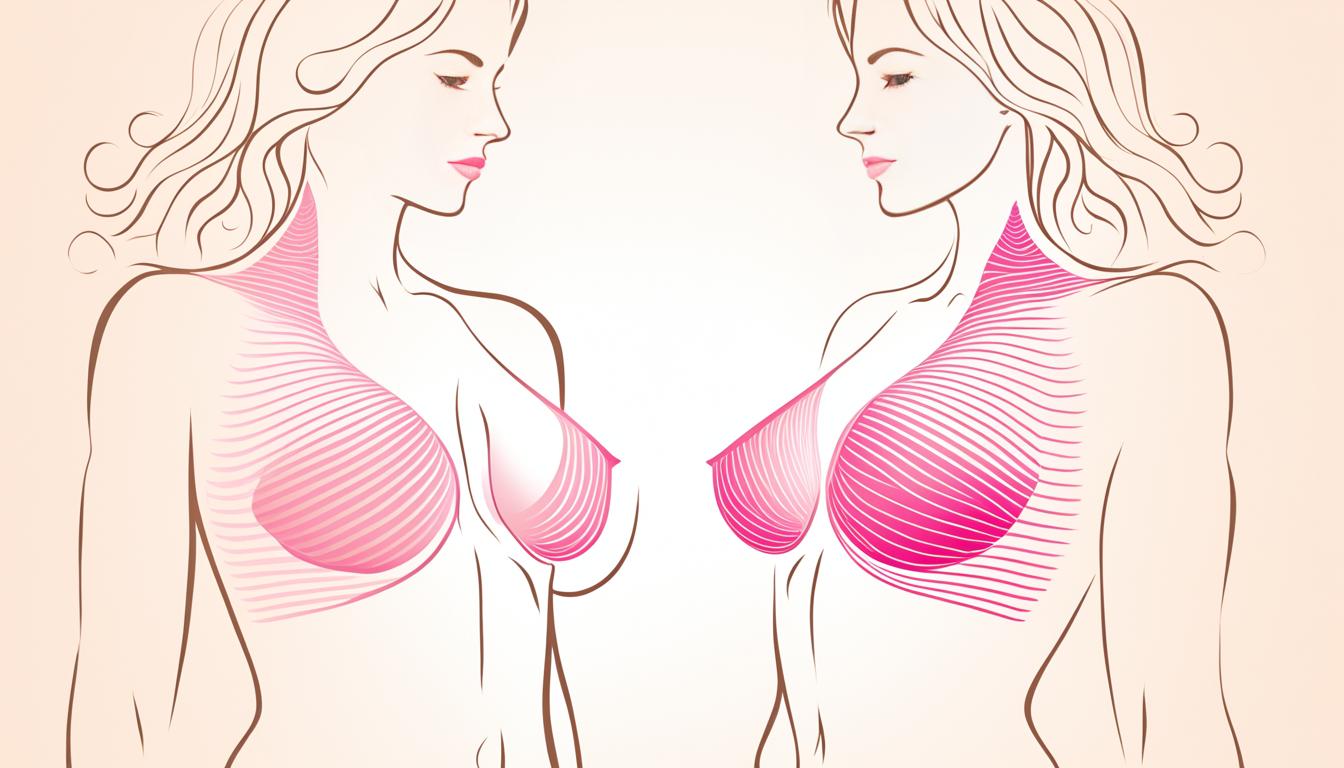Many women, myself included, often think about our breasts’ size and shape. We feel pressure from others and from within. Could it be that our genes determine more than we believe?
Research shows that our genes significantly influence the size of our breasts. In twin studies, it was found that 56% of breast size variation is because of our genes. This is more than, for example, our genes’ effect on becoming obese. Basically, our genetic makeup greatly affects how our breasts look.
This was a mystery until recently, when a groundbreaking study revealed more. Scientists discovered certain genes tied to breast development. This finding highlights the complex mix of genetics, hormones, and our surroundings that shape our breasts’ size.
Key Takeaways
- Genetics plays a significant role in determining breast size, accounting for up to 56% of the variation.
- Breast size heritability is largely independent of obesity genetics.
- This groundbreaking GWAS study uncovered specific genetic factors underlying normal breast development.
- The research aims to explore the connections between breast size genetics and breast cancer genetics.
- Understanding the genetic influences on breast size could offer valuable insights into breast cancer risk and prevention.
Introduction
Breast morphology is important when we talk about breast cancer risk. This includes things like breast density. This means the percentage of non-fat tissue seen on a mammogram.
Another factor is body weight, which affects breast size. High weight when young makes breast cancer risk go down. But, weight gain later in life does the opposite. It increases the risk post-menopause. Breast asymmetry might play a part too. Research isn’t sure about the link between breast size and cancer risk yet. Some say bigger breasts mean higher risk in slim women.
Breast Morphology and Cancer Risk
Breast morphology, like how dense it is in a mammogram, impacts breast cancer risk. Mammographic density is the amount of non-fat breast tissue showing on a scan. It’s a well-known breast cancer risk.
Body weight and breast size also affect the chances of getting breast cancer. Women heavier when younger, during which time less cancer risk is there. Yet, gaining weight later increases the risk.
Concerning asymmetry, mixed studies connect it to possibly facing more breast cancer risks. For slim females, a link between bigger breasts and heightened cancer risk exists.
Mammographic Density and Breast Cancer
Mammographic density shows how much dense tissue is in a mammogram. For women with high density, the risk of breast cancer is 4 to 6 times higher than for those with low density.
Body Weight, Breast Size, and Cancer Risk
Body weight, linked to breast size, offers interesting insights. More weight at a younger age lowers the chance of pre- and postmenopausal breast cancer. But, gaining weight in adulthood raises the postmenopausal risk.
Breast Asymmetry and Cancer Risk
Research suggests more pronounced symmetry differences might increase the breast cancer risk. In this case, women with greater asymmetry could face a higher risk than those more balanced.

Genetic Factors in Breast Size
Research on genetics and breast cancer risk is thorough. Many genetic links to breast cancer have been found. But, not much is known about the genetic factors for average breast size.
Previous studies focused on breast cancer, not breast size. Before this study, there was only one on breast size and a few on breast density.
Heritability of Breast Size
Studies with twins show breast size is 56% due to genetics. But only one third of that is related to the genes for heritability of obesity. This means the genes for breast size are different from those that affect our body weight.
Before this study, we didn’t know the specific genes that affect breast size. The research changed that. It’s the first to extensively explore the genetic factors in breast size.
The work involved 16,175 European women. It found seven genetic markers linked to bra cup size. This study is a big step in understanding how genes shape breast size. It also hints at how breast size genetics and breast cancer genetics might be related.
Study Methods
This study looked into the genes behind normal breast growth. It included people from 23andMe, a top genetics company. All who joined were women of European descent. They didn’t have a close genetic link, making the study fair.
Participants and Ancestry
There was a wide mix of people in this study, sharing truths about breast size genes. The research used 23andMe’s rich genetic data. This helped make sure the study group matched Europe’s diversity.
Genotyping and Imputation
People took part used Illumina’s tech for genetic testing. They got a detailed genetic view. Then, their genetic info was matched against a big reference. This let the team find more genetic clues about breast size.
Phenotype Data Collection
Along with genes, participants shared data via a site form. They told their bra size, age, and if they had kids. This mix of info helped see how genes link to breast features.
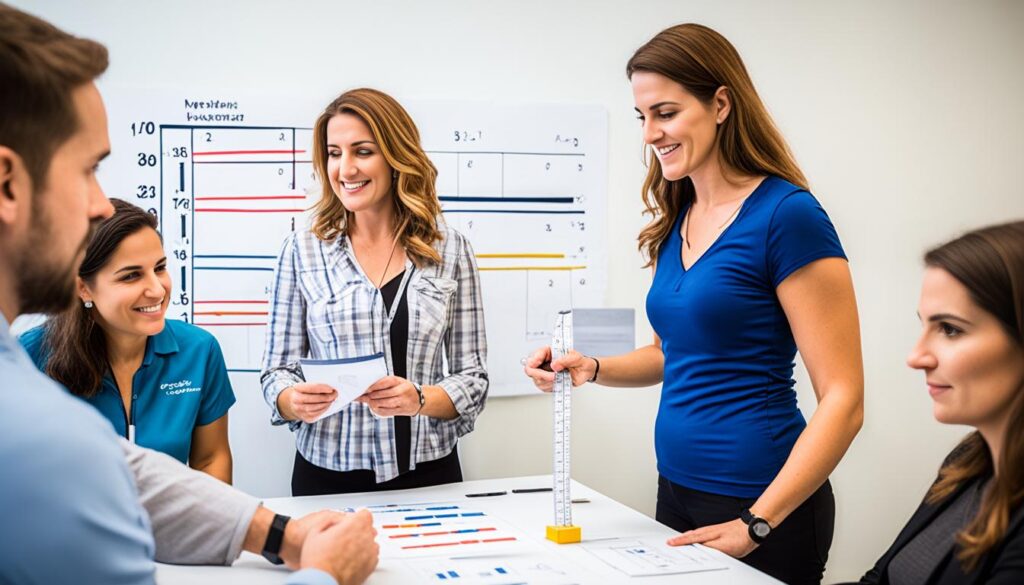
What Role Does Genetics Play in Breast Size?
Significant Genetic Associations
A genome-wide association study (GWAS) found seven spots in our DNA really linked to breast size. These results help us understand the genetics of normal breast growth.
Connections to Breast Cancer Genetics
Two out of the seven spots known for breast size link up with areas connected to breast cancer genetics. A third spot, although not directly linked, is close to a known cancer spot. This hints that some areas affecting breast size might affect cancer risk too, but it’s a complex link.
The other four spots from the study also connect well with breast cancer, how estrogen works, and breast growth. This shows a deep connection between what affects normal breast shape and breast cancer risk factors.
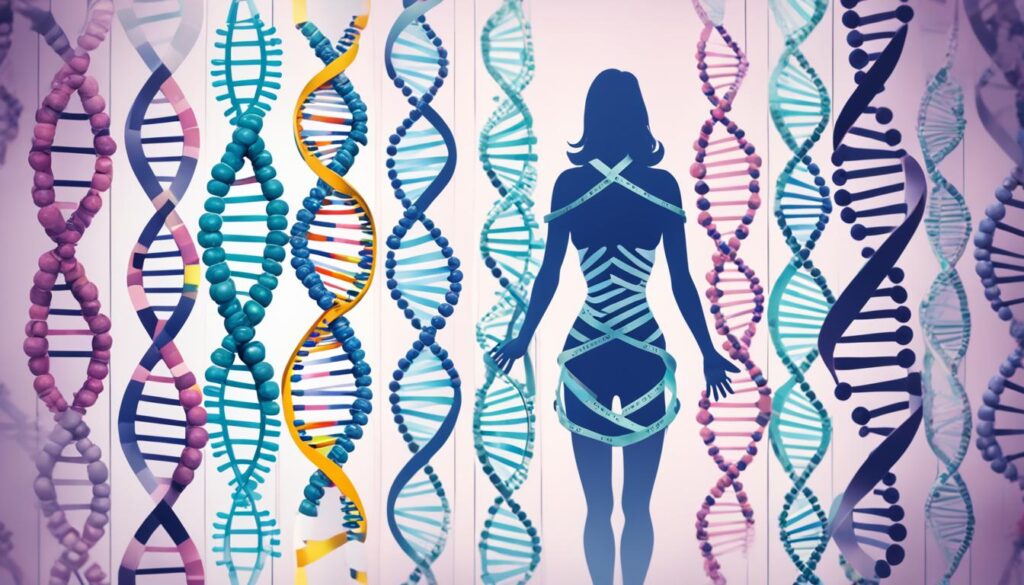
Biological Pathways Shared
This study found some important connections in genes tied to both healthy breast growth and breast cancer. A key finding was a single-nucleotide polymorphism (SNP) named rs12173570. It influences the estrogen receptor gene, crucial for breast development and linked to most breast cancer cases.
Estrogen Receptor Gene
The study hints that the estrogen receptor gene might link breast size to cancer risk. As an example, SNP rs7816345 points to a specific region (8p21) in the genome. This area is often problematic in certain breast cancer types, showing how genes can affect both breast growth and cancer.
Breast Density Genetic Factors
Other research has pointed to genes that affect breast density, a known cancer risk factor. This study suggests one of these genes might also influence breast size. It shows the same biological pathways can be involved in breast growth and cancer development.
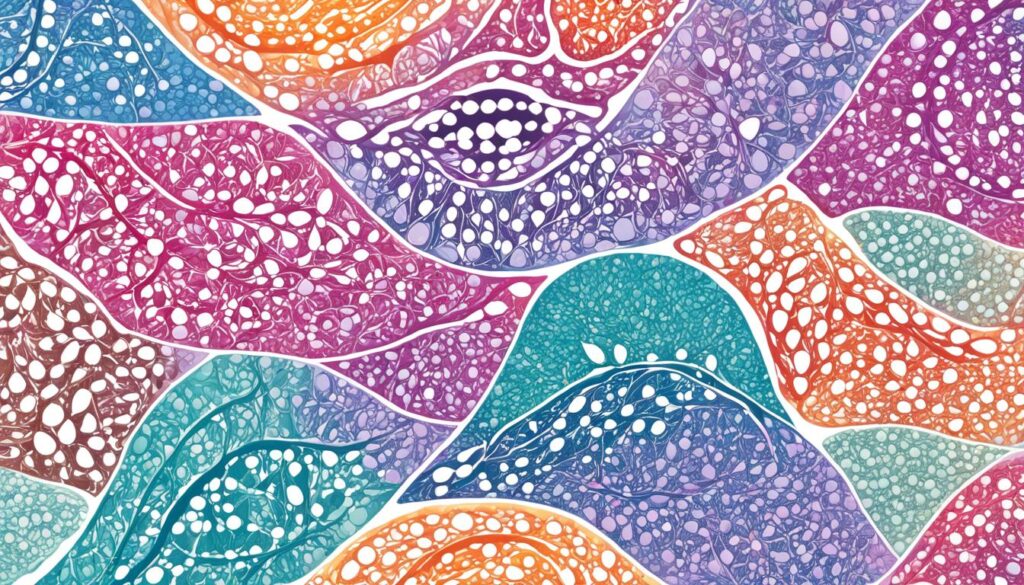
Complexities in Breast Size-Cancer Link
This study gives us some clues about how genes connect breast size to the risk of getting breast cancer. But, the link is not simple. For example, some research shows that in thin women, a bigger breast size may mean a bit more risk of breast cancer. However, the genes we found are not all there is to this story. Many things like hormones, the environment, and more could also affect this link.
The reason why breast size might influence breast cancer risks is very complex. These findings shed light on the roles of certain genes in both growing breasts normally and fighting off cancer. Yet, we still need more studies to understand how exactly genetics and other factors work together in this process.
| Factor | Relationship to Breast Size | Relationship to Breast Cancer Risk |
|---|---|---|
| Genetics | Genetic factors identified in this study are associated with variations in breast size. | Some of the genetic factors linked to breast size are also associated with breast cancer risk. |
| Body Weight | Higher body weight is generally associated with larger breast size. | Higher weight at younger ages decreases both premenopausal and postmenopausal breast cancer risk, while weight gain in adulthood increases postmenopausal breast cancer risk. |
| Hormones | Hormonal factors play a crucial role in breast development and size. | Hormonal imbalances and disruptions can contribute to both breast cancer risk and variations in breast size. |
| Environmental Factors | Environmental influences, such as diet and lifestyle, can impact breast size and development. | Environmental exposures may also influence breast cancer risk, independent of breast size. |
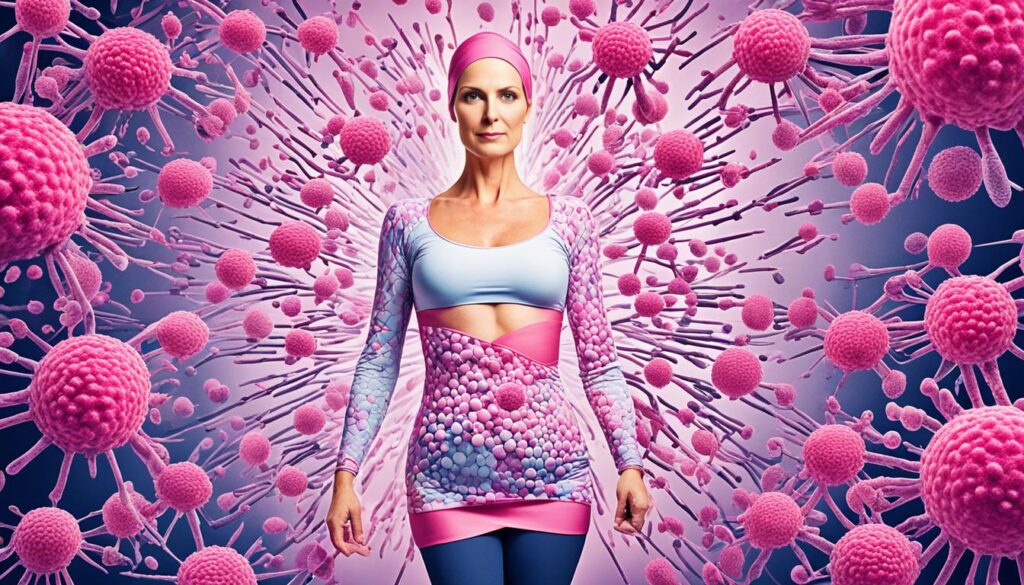
Implications and Future Research
The link between genes, breast size, and breast cancer isn’t totally clear yet. But, these discoveries show us where to look in our cells. More studies are needed to understand how the genes for breast size and breast cancer work.
Understanding Gene Functions
This study found certain gene types linked to bra cup size. These genes give us new info about how our breasts grow. Knowing more about these genes helps see what shapes our breast size.
Insights for Breast Cancer
We might understand and treat breast cancer better because of this. Finding common genes between breast size and breast cancer is a big step. It could help stop cancer early and make specific treatments.
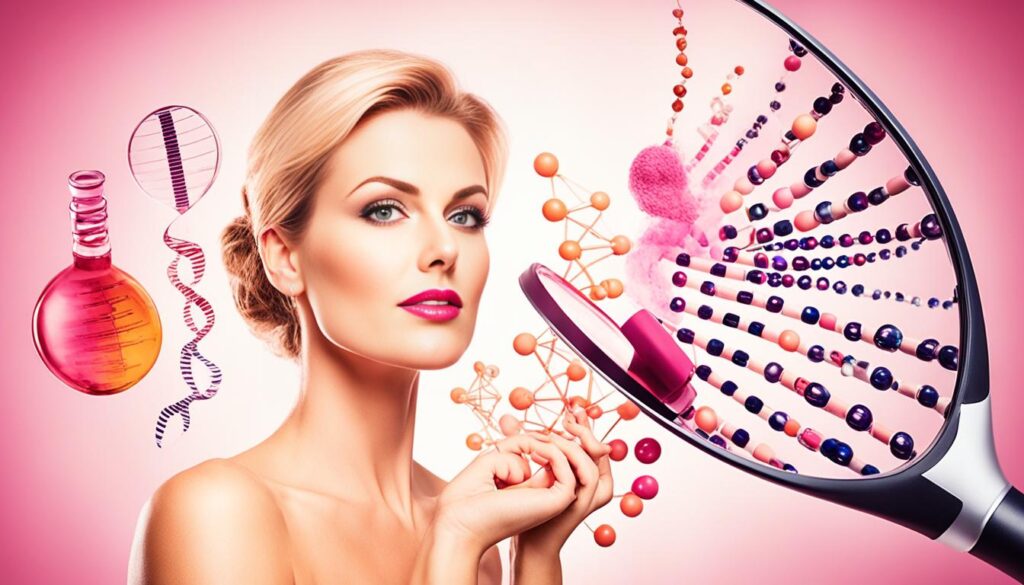
Conclusion
This study has found new links between our genes and breast size. It shows that seven genetic variants can impact the size of bras women wear. The results hint at a link between how big our breasts are and the chance of getting breast cancer.
The findings highlight that genes can affect not just how our breasts grow, but also our risk of breast cancer. This could lead to better ways to prevent and treat breast cancer in the future. By digging deeper into how breast size and cancer risk are connected, we might come up with more powerful ways to fight this disease.
In summary, this research uncovers important details about how our genes influence breast size and cancer risks. Understanding these links could help us develop better care for those with breast-related issues. The path forward looks promising for more breakthroughs in this crucial research area.
